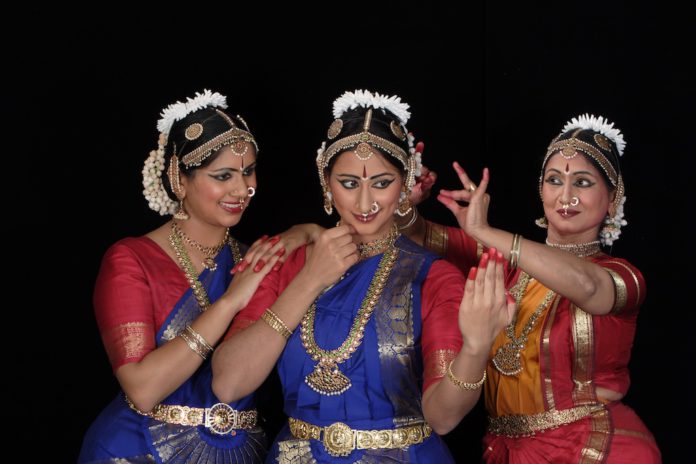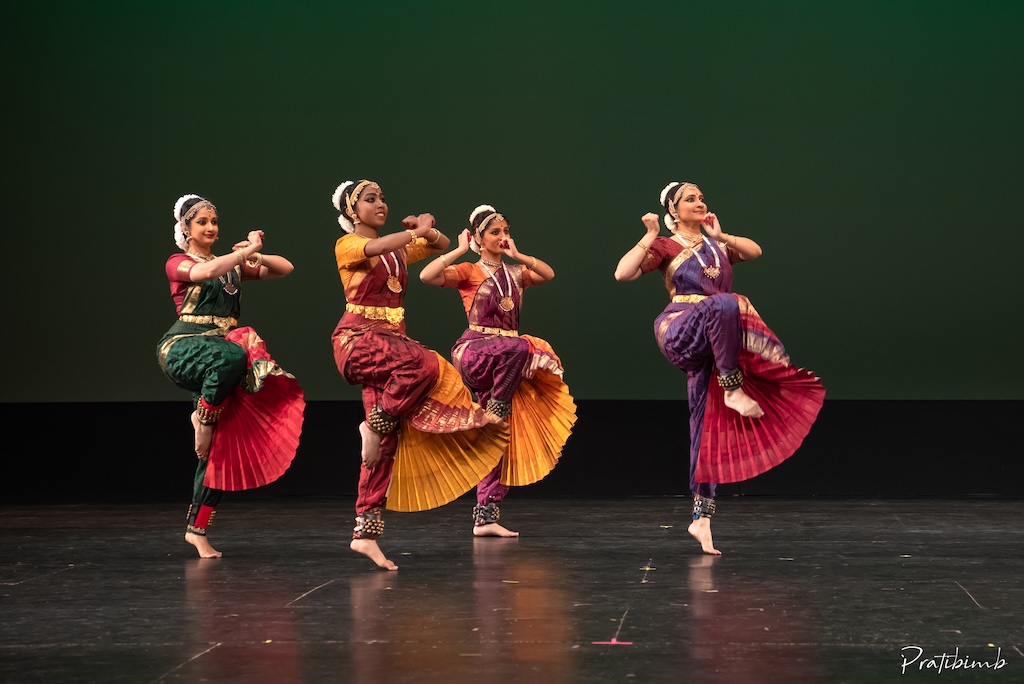
When Mythili Kumar first arrived in the United States at age 22, she brought with her a deep-rooted love for Bharatanatyam, the classical South Indian dance form she’d trained in since childhood. But it wasn’t until she arrived in the Los Gatos area that her passion found the foundation to grow.
And over the years it would blossom into one of the Bay Area’s most respected Indian classical dance companies.
This summer, Abhinaya Dance Company celebrates its 45th anniversary with “Natya Dhaara,” a performance that translates to “the unceasing flow of dance.” The show, set for Aug. 3 at Cañada College in Redwood City, honors not only Kumar’s lifelong devotion to Bharatanatyam but also the community that shaped her journey.
“There weren’t many opportunities for me to dance. I was dancing professional concerts maybe once or twice a month,” Kumar recalls. “So, I started teaching.”
Kumar settled in Mountain View before making her home in Monte Sereno. It was here in the early 1980s that she began to lay the groundwork for what would become Abhinaya. “Music was a hobby for my husband, and he had a lot of musician friends,” she says. “And with the community of friends that I had at the time, we would all get together and talk.”
Conversations with other Indian families—many of them, like her, raising children in a culture far from home—sparked an idea. “We all wanted our children to have a connection to culture,” she says. And so, the parents rallied and asked Kumar to teach their kids.
In 1980, after a few years of teaching, she officially founded Abhinaya Dance Company.
Her first student performed an Arangetram—the solo debut performance of a Bharatanatyam dancer—in 1983.
From there, Abhinaya slowly took shape, becoming a formal company with continued community encouragement, support in the form of grants and a steadily growing roster of students, performers and musicians. “I was teaching in someone’s garage at first, and we started with only the few musicians that we knew here,” she says.
‘Bharatanatyam is an art’
—Mythili Kumar
“Bharatanatyam is an art; and it’s culture,” she explains. “And by teaching it, you’re propagating it; you’re imparting culture.”
In India, dancing was stigmatized in the past, Kumar says. “(Dancers) lived at the temples, had dedicated patrons, and they would be devoted to dancing and nothing else. Eventually because of British colonization, patronage to temples changed. But dance was still associated with immoral behavior.”
When Kumar began showing interest in learning dance at an early age, her parents were very supportive. “But, when I got married, my in-laws didn’t expect I would continue to dance,” she recalls. “Now, 50 years later—in India as well as here—the stigma is no longer there. Dance has been adopted as a means of keeping in touch with our culture.”
Every dance in a program draws from ancient poetry, with themes that range from Hindu mythology to reflections on figures like Mahatma Gandhi. Kumar selects poems thoughtfully, using decades of experience to interpret the verses in ways that feel timely and heartfelt.
The stories are central to the upcoming “Natya Dhaara” celebration, which Kumar has choreographed using traditional Bharatanatyam vocabulary and South Indian Carnatic music. Tradition is expected, and it is what makes Bharatanatyam such an extraordinary art form.

While Bharatanatyam often relies on established choreography, there’s room for improvisation—particularly in solo pieces. Still, Kumar says, the discipline required is immense. “Like ballet, every movement is choreographed in advance,” she says. “But within that, there’s freedom. In a solo performance, dancers will often improvise their facial expressions and arm movements for emphasis or to add more emotion.”
The music is equally as essential. In the 1990s, Abhinaya pivoted to a more collaborative approach, inviting a wide range of musicians to deepen the synergy between sound and movement.
“We started diving deeper into mythology, and integrated poetry by English authors,” she says. Kumar says this helped them draw in new audiences and innovate their programs. “We also invited a lot of trained musicians, not only to participate in our shows, but to help us compose new pieces we wanted to create.”
In addition to Kumar, this year’s live ensemble features Asha Ramesh, Shanthi Narayan, N. Narayan and Srikanth Chary. Also part of the production: her youngest daughter, Malavika Kumar Walia. Malavika’s older sister, Rasika, is also involved in the company.
“My older daughter, who works at Google right now, I always tell her she has a mathematical mind,” Kumar laughs. “But I understand and appreciate her approach to group choreography. My other daughter is a talented cymbalist, and she also trains the junior dance company, making them look equally as professional as our company dancers.”
Now, looking ahead to the 45th anniversary of Abhinaya, Kumar reflects with pride at what she’s helped create in her community. For Kumar, bringing Bharatanatyam into the public eye has always been about more than just the performance. It’s meant building bridges—between generations, cultures and communities.
“We don’t compromise on our traditional repertoire, in terms of vocabulary. But we incorporate different ideas, and different stories,” she says. “People appreciate seeing influential figures like Martin Luther King Jr. and Cesar Chavez, their lives, thoughts and struggles being portrayed in dance.”
Abhinaya has collaborated with Japanese taiko drummers from SJ Taiko on several occasions and a Balinese ensemble. “In these collaborations we learn that there are always commonalities to be found. It’s about putting egos aside and working together to create something bigger, something beautiful for the community to enjoy.”









